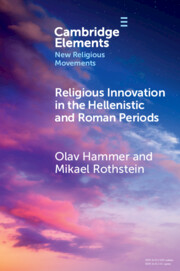Element contents
Religious Innovation in the Hellenistic and Roman Periods
Published online by Cambridge University Press: 24 July 2023
Summary
Keywords
- Type
- Element
- Information
- Online ISBN: 9781009030106Publisher: Cambridge University PressPrint publication: 10 August 2023
References
Primary Sources
Secondary Sources
- 7
- Cited by



